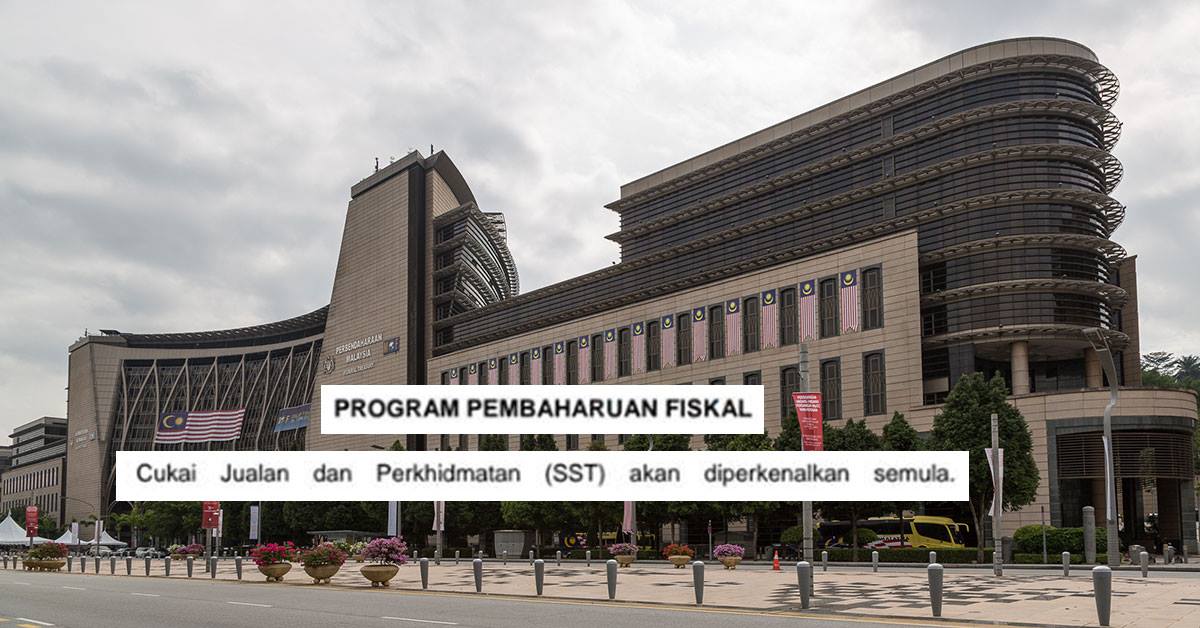- After announcing the reduction of GST from 6% to zero beginning June 1, the government then announced the reintroduction of SST at date to be announced.
- Predictably, confusion among the Malaysian public regarding the upcoming changes caused a number of inaccurate statements to appear. We address 3 major misconceptions and attempt to set things straight.
On May 16, Malaysia’s Ministry of Finance announced the zero-rating of our Goods and Services Tax (GST) across all products and services both local and imported. Yesterday, they followed up on that announcement by declaring the return of the Sales and Services Tax (SST)—the one that the GST replaced back in 2015 under Najib’s administration.
In a post on their Facebook page, the Ministry of Finance highlighted concerns regarding the removal of the GST, and by relation, the government’s ability to reduce the national debt.
“Fiscal reformation programmes are being executed,” the statement read. “The reduction of income as a result of the GST being reduced to zero starting June 1 2018 will be offset by specific income and expenditure-focused procedures that will be announced soon.”
“The Sales and Services Tax (SST) will be reintroduced.”
These announcements arrived as expected following Pakatan Harapan’s win in the 2018 General Elections last week. Leading up to their win, Pakatan Harapan promised in their manifesto to scrap the GST within 100 days and bring back the SST should they successfully win the majority vote.
Now that they’re delivering on their promises, Malaysian businesses and consumers are gearing up to accept the changes, but not without some early confusion.
Following the announced return of the SST, many online netizens have been actively disseminating speculative information regarding the impending switch up that might not be completely accurate. Here are some of the more widespread ones (along with our best efforts to set the record straight):
1. The GST goes away on June 1, and the SST will also return on June 1.
Now while many are celebrating the reduction of the GST rate from 6% to 0%, there are also a huge number that are mistaking it for the absolute dismissal of the GST altogether. This is not accurate.
As stated in the official announcement, the GST will continue to remain, but at a rate of zero. This is because as with all tax policies, the removal of the GST is dependent on our parliament repealing the GST Act of 2014 before it can be fully abolished.
Also we shouldn’t forget that completely scraping GST also involves the changing of various tax reporting and filing protocols that have become commonplace since its introduction in 2015.
And finally, while the Ministry of Finance did announce the reintroduction of the SST, there was no actual date mentioned regarding its actual reimplementation. Still, we can expect that the SST to return sooner rather than later, if the speed at which things are being done is any indicator.
2. “SST will mean lower product prices” vs “SST will mean higher product prices”.
The debate surrounding how prices will fluctuate after SST replaces GST seems split two ways, with a portion of Malaysians expecting prices of goods to drop and some others believing otherwise.
The answer to this debate isn’t so straightforward, as it all depends on a number of factors such as:
- How many levels there are in the product supply chain (the number of entities there are between manufacturer and consumer).
- The type of product considered (things such as automobiles may be affected differently from other things such as mobile phones or event food items).
- Tax exemptions for businesses (for example, properly registered businesses are entitled to reclaim GST incurred on items purchased through tax input rebates).
- How businesses themselves deal with pricing (for example, F&B outlets that chose to retain a “service charge” on their menu items despite the service tax portion of SST being removed and replaced with GST).
In the “SST will make things cheaper” corner, the argument is:
- SST previously imposed upon certain goods at the first level was sometimes higher than GST’s current 6% (pre-2015 SST rates ranged from 5% all the way to 25% depending on the category of product) but,
- The imposing of GST at all levels of the supply chain (as opposed to SST at only the initial output level and retail level) had caused businesses to spike up their prices (even despite being able to reclaim the cost of GST through tax input rebates).
Also supporting the argument is the possibility that the number of goods affected by SST will be significantly less compared to what is taxed under GST. For example, Touch n’ Go reloads, and interbank ATM withdrawals were some of the things that weren’t subject to any taxes during SST, but were included under GST when it rolled out.
Conversely, the argument that “SST will make things more expensive” also has some credence. If following the old rates, some items under the SST can be expected to increase in price (liquour was taxed at 20% under SST, and cigarettes were taxed at 25%), although the rates for the new SST is still subject to an official announcement.
Long story short, Malaysians can expect prices to adjust differently based on the type of good or service being paid for, and that there is no actual black and white outcome that can be expected from this change—the only thing to do is to wait and see just what kind of rates our government will set for the upcoming SST, and what items will/will not be affected.
3. “But the government will have a shortage of income to pay off our national debt.”
A concern made relevant after Pakatan’s win, many Malaysians are now questioning if our new government will have income enough to bail Malaysia out of its approximately RM600 billion national debt.
While we’d love to provide a definite answer explain just how the government will be able to cover our the massive financial shortfall, we can only honestly say that it’s all up to speculation and that we can expect our new government to announce many other measures to deal with the debt in the near future.
For example, the announcement for SST also came with a positive update regarding global prices for crude oil (one of the key contributors to Malaysia’s GDP), and indicated that the windfall from this occurrence would only assist our government in dealing with the debt.
“The global price of crude oil has visibly risen against the estimates of the 2018 national budget, which stood at US$52 a barrel. This will provide some fiscal leeway for the foreseeable future.”
– Ministry of Finance
This announcement combined with other current initiatives such as the ongoing investigations into 1MDB, the appointment of the Team of Eminent Persons, and other cost-cutting measures will hopefully go a long way to solving the problem of leveling our financial dues, so best to wait and see how things pan out.
###
It’s only been just over a week since the change in Malaysia’s government, and yet so much is already happening. And as expected with the flurry of things going on at various levels in the administration, confusion and misinformation is always a real risk.
Hopefully with the passing of time, we can expect things regarding our nation’s financial status to become clearer, and that our current administration can continue to allay any concerns we have through regular announcements.
- In the meantime, you can read our predictions of how Pakatan Harapan’s win will affect our economy here.
- Or read about how business owners will have to adapt to zero percent GST here.
Feature Image Credit: CEphoto & Kementerian Kewangan Malaysia










